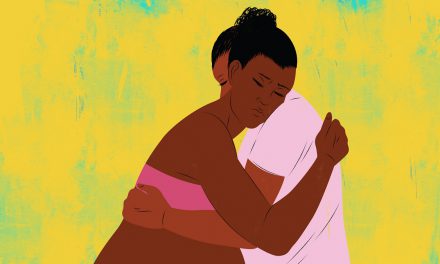“You know you’re not okay, right? You’re going to have to talk to somebody.”
These words, uttered by a concerned coworker, were the turning point for April Scott to seek help for her suicidal thoughts. Scott’s first pregnancy was a breeze, but her second brought relentless doubt, fear for her ability as a mother, and severely worsened mental health symptoms. She knew she was in danger when she began obsessively thinking about the handgun in her purse, but providers missed several opportunities to intervene.
Out of fear of being labeled an unfit mother and being separated from her children, she refused to speak up about what she was experiencing. It wasn’t until her coworker confronted her directly that she realized she needed to be honest with her loved ones. Even then, access to treatment and other resources took months to receive, prompting a further discussion about the responsibility of providers in suicide prevention.
In honor of Suicide Prevention Awareness Month, observed annually each September, the Missouri Behavioral Health Council and Missouri Department of Mental Health hosted a webinar series highlighting risks associated with suicide. The series began with “New Mothers in Crisis: Research Findings and a Mother’s Personal Story,” featuring Rebecca Ray, MA, PLPC, who worked on the Suicide Prevention Lifeline for several years and now offers various counseling services. Through StressSight she helps patients become aware of a variety of influences on their stress levels. Ray laid the foundation with new research surrounding suicidality in new mothers before Scott shared the story of her own struggle with mental health as a mother of two.
Data surrounding suicide is difficult to measure due to the lives lost, but also because of the stigma associated with mental health and suicidal thoughts or ideation. People who are struggling or do not understand what they are experiencing may not be transparent with others. When substance use is present, their death may not be accepted as a suicide by loved ones or their community. While new research presented in this series aims to highlight early opportunities to intervene and prevent suicide, survivors and their stories offer even more valuable guidance.
Suicide and Access to Lethal Means
Following the birth of her first son, Scott experienced the normal baby blues, a period of overwhelming emotions that commonly occurs throughout pregnancy and childbirth. Her transition from the hospital to home was seamless, she had a large support system, and she felt confident as a mom.
As her son grew older, Scott and her husband decided to add to their family, but experienced two devastating back-to-back miscarriages. “For both myself and as a family unit, it was difficult to navigate,” she said. After seeing a specialist and receiving treatment for a uterine polyp, she discovered she was pregnant again.
During her pregnancy with her daughter was the first time Scott considered suicide. “I could just feel the dread and anxiety, I had this overwhelming feeling,” she said. The thought first occurred during an anxiety attack in the middle of the night while her husband was gone. “In that moment in time, all I could think of was the gun in my purse next to my bed in my room. That was the only thing I could think of at three in the morning was to immediately move it, lock myself in the bedroom, and calm myself back down.”
The only thought able to calm Scott down was considering the consequences of her actions. “I can’t do that, my son is downstairs, my husband’s not here, I’m pregnant, I can’t do this,” she repeated to herself. But the feeling never disappeared. “The further along I got with my pregnancy, I did not mention it to anyone. I kept it to myself because I thought it was just a fleeting thought I would get over. I was obsessive over that thought.”
Though she was drawn to the gun she carried with her daily, she hunted with her family growing up, had access to nearly 20 other weapons, and continually sought out other means. “There is my gun in my purse sitting next to me in the passenger seat,” she thought. “I have to cross a bridge every day to get to work – I thought about driving off that every day. My only thought was that I was pregnant – I didn’t care about me, I just cared about her and my husband and my son.”
New Mothers and Mental Illness
Though Scott and her husband immediately fell back into the role of new parents naturally, things changed when they went home. Her husband didn’t receive time off to be with them while their son started preschool, leaving her mostly alone outside of help and company from her mother.
During the day, while caring for her daughter, everything felt fine. “But every single night, as soon as night would fall, I could feel the anxiety again,” she said. “I could feel it moving up my body to the point where I would feel like I was hyperventilating because I didn’t know what would happen during the night.”
She felt the anxiety worsen throughout her maternity leave and eventually stopped responding to people, using social media, and even leaving her house. Her husband felt this was more than the expected baby blues, pointing out she was no longer leaving even to get groceries and would not shower for days at a time. In an attempt to help, he invited her out with friends which she dreaded the entire time, causing her to sob and be angry with him and feel forced into an uncomfortable situation.
“He was just trying to do his best,” she said, noting that she was able to feel better seeing friends and watching them interact with her daughter. “But I still didn’t feel like myself.” After returning to work, she continued to run through the motions during the day and lie awake at night when the dread would come.
According to Ray, mothers struggling with mental health concerns, such as Scott and her anxiety, are at increased risk of suicide. Maintaining baseline necessities, such as getting enough food and sleep, are crucial to maintaining both physical and mental health.
“We really want to look at that for the moms, the partners, the family: what’s happening in the area of sleep?” Ray said. “It’s important to understand what may be happening and see if things are changing or worsening and what we need to do for the mom.”
Biophysical risks associated with suicide include:
- Family or personal history of mental illness or suicidal behavior.
- Substance use.
- History of violence, abuse, trauma, or mistreatment.
- Social context and support such as economics, housing, immigration status, race, community, etc.
- Biological and physical health issues.
- Mother-baby relationship and support system (or lack of).
Many red flags surrounding suicide may be symptoms commonly associated with mental illness, substance use, or other cooccurring risk factors. It may be difficult for the mother or her loved ones to recognize the severity, especially if she is not already aware of pre-existing mental health issues.
Experiencing baby blues following childbirth is expected, but support systems, including providers, should be cognizant of indicators that mental illnesses may be developing or worsening. A 2021 University of Michigan report studying trends in suicidality one year before and after birth found correlations between an increase in feelings and thoughts of suicide in women of childbearing age as well as an increase in women with depression, bipolar, and psychotic disorders experiencing suicidality.
Data from the study shows that even women with no history of bipolar disorder can have a child and suddenly experience symptoms – not that they weren’t present before, but childbirth acted as a turning point. This point, Ray said, is important to pay attention to and intervene prior to. Scott, for example, knew she had anxiety and obsessive-compulsive disorder (OCD) as an adolescent but recognized both worsened following her daughter’s birth.
“More often than not, experiences of suicidal feelings or thoughts are common after delivery,” Ray said. She pointed out the need to recognize red flags and understand the importance of acting early. “These symptoms may not necessarily turn into postpartum psychosis, but we need to be aware. A woman might have had a baby five years ago and those mental health issues are still there five or ten years later.”
New mothers especially experience doubt and struggle to find balance between feeling alone in their struggles yet fearing being stripped of their children if they ask for help. “They may feel like, ‘I don’t know if I’m doing this right,’” Ray said. “It’s going to be unique for every mom. This information is about observation and awareness. How is this mom feeling about what her new situation is like?”
Confronting Suicide by Name
When Scott’s coworker confronted her, she was at a complete loss. “The first thing I said was, ‘I’m not okay. I know I don’t want to hurt myself, I don’t want to hurt my kids, but I know how people can. But I’m not going to call someone and tell them that and get my kids taken away.”
While she recognized she needed help and began being transparent about her suicidality with her support system, she struggled to receive adequate treatment out of fear of being stigmatized and subsequently losing her children. Medications she was prescribed were either intolerable or felt like they made no difference, and suicidal thoughts and nightly dread worsened.
One day, she bluntly addressed her fears with her mother, specifically explaining her obsession with her handgun and asking her mother to keep it. At her mother’s request, Scott took the gun apart and her father hid it from both women. According to Scott, her mother didn’t want her to return saying she felt okay and take the gun back in case her suicidal thoughts continued.
After spotting a burglar around her house, she felt guilty for not having her gun available to protect her family. Following an under-the-breath comment about it being a bad day to give her gun away, her husband asked what was going on, prompting her to finally say out loud, “I’ve seriously considered suicide for over a year now.”
When asked what took her so long to talk about this, she answered, “I didn’t want you to think less of me as your wife, as a person, as a mom. I didn’t want you to be worried about my ability to take care of our children.”
Though the conversation was difficult, it was necessary, and they quickly sought out treatment options. However, many resources were not available sooner than four months. “The only other way I would have received the help I needed is if I went into the ER and said I was in crisis,” Scott said. “I was not going to do that because my immediate fear was that they would take my kids and I wasn’t going to let that happen.”
While she began talking to her husband, coworkers, and doctors more honestly about how she felt, she recognized that she had exhibited several warning signs that should have been confronted earlier. While providers did take time to check in during appointments, especially due to her history with miscarriages, they did not pick up on her anxious worrying and abundance of questions.
The main questions providers asked were whether she wanted to hurt herself or her kids, to which she replied, ‘No, but I could, and I understand why people want to.’ “They didn’t necessarily zoom in on that and ask me any questions further,” she said.
Though she started receiving treatment and taking an antidepressant, the results were not immediate. “It doesn’t take away those thoughts, feelings, or worries – you have to give it time,” she said. “But a lot of women in those circumstances have already run out of time. Having a plan and verbalizing that is a red flag that people need to watch,” she pointed out. “You’re not always going to feel it, it may be a fleeting thought, but it exists in the back of your mind.”
“My turning point when I talked to my mom and husband was when I actually did have a plan and I knew it would work,” she continued. “I knew what time my husband would be home, what time my daughter took her nap, and when our son would be occupied. I would take the gun that I carry for my protection, take my kids inside, go outside and get in my car and shoot myself.”
“Every time I thought about it, I had a very surreal feeling. I felt indifferent to the whole thing. You would think at some point in time you would stop and go, ‘I don’t want to do that.’ But I got to the point where I thought, ‘Eh, sounds good to me.’ For a while, it really feels like that’s your only option, that’s all you have.”
The Importance of Intervention
Scott didn’t begin receiving treatment until four months after seeking it out due to referral processes and other new patient intake requirements. Because she wasn’t actively hurting herself or suicidal thoughts were deemed fleeting, some facilities didn’t consider her situation urgent.
To properly navigate suicidal ideation, and the patients affected by it, Ray suggests watching for red flags including:
- Recent significant change in mental state or emergence of new symptoms.
- New thoughts or acts of violent self-harm.
- New and persistent expressions of incompetency.
Ray provided real world scenarios of mothers reporting early postpartum mood changes, strong beliefs of inadequacy as a mother, worsening mental health symptoms, violent suicidal thoughts, and even suicidal attempts. In all three scenarios, these concerns were downgraded, especially where suicidal thoughts were deemed fleeting or impulsive. “It’s important that she’s having these thoughts,” Ray said, and cautioned against associating lack of physical harm with lack of intent.
While Scott recognized she was struggling early on and knew she had a team full of love and support, the direct confrontation from her coworker steered her to seek treatment. Many people mentioned negative changes in behavior, such as her not leaving the house or being late when she did, but hearing, ‘You’re not okay and that’s okay,’ did much more to soothe her anxiety.
Now, her support system is aware of her history and checks in consistently, even asking point blank about suicidal thoughts when they are concerned. “Their compassion goes a long way,” Scott said. She pointed out that addressing suicide by name and normalizing it throughout her journey and consistently still has been crucial to feeling comfortable seeking help.
“You’re definitely not alone; don’t feel like you are,” she said. “We’re all in this together and we have to be able to be open. I know what it feels like to be there. Never feel guilty for something you can’t control.”
Watch the recorded webinar to see research surrounding new mothers and mental illness and hear more about Scott’s journey: https://missouribhc.app.box.com/s/weqvoe3735mbg721fzhl54oashd0cfch
Register for the remaining webinars in the series: https://web.cvent.com/event/4b5031a6-d485-4ada-b0f2-d1771e2614d5/summary?locale=en-US&i=7ovviZWYnk2W-EQFcDJ9XQ
Read part two of the Suicide Prevention Series.








